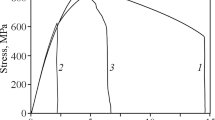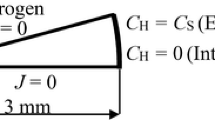Abstract
The effects of hydrogen on ductile fracture were studied in two spheroidized plain carbon steels, containing 0.16 and 0.79 pct C. A combination of fractography and quantitative metallography on sectioned, deformed specimens permitted separation of the effects of hydrogen on the initiation, growth, and link-up of voids. In both steels, hydrogen was found to have no significant effect on either the initiation of voids at carbides, or early growth of voids, prior to link-up. In the higher carbon steel the fracture surface dimple size increased after hydrogen exposure with no other evident change in the fracture surface appearance; it is therefore inferred that hydrogen primarily assists void growth during link-up in this steel. In the lower carbon steel the fracture appearance changed and a decrease in void size due to hydrogen was found fractographically; thus, both initiation and growth of voids are apparently enhanced during the link-up phase of fracture in this steel. It is hypothesized that these effects may be due largely to a void pressure mechanism if hydrogen is transported by mobile dislocations.
Similar content being viewed by others
References
I. M. Bernstein and A. W. Thompson:Int. Metall. Rev., 1976, vol. 21, pp. 269–87.
A. W. Thompson:Effect of Hydrogen on Behavior of Materials, A. W. Thompson and I. M. Bernstein, eds., pp. 467–77, TMS-AIME, New York, 1976.
I. M. Bernstein, R. Garber, and G. M. Pressouyre:ibid, pp. 37–57.
R. Garber, I. M. Bernstein, and A. W. Thompson:Scr. Metall., 1976, vol. 10, pp. 341–45.
A. S. Argon and J. Im:Met. Trans. A, 1975, vol. 6A, pp.839–51.
H. C. Rogers:Ductility, pp. 31–61, ASM, Metals Park, OH, 1968.
R. H. Van Stone and T. B. Cox:Fractography-Microscopic Cracking Processes, ASTM STP 600, pp. 5–28, American Society for Testing and Materials, 1976.
R. H. Lauderdale:Met. Prog., 1967, vol. 88, December, pp. 79–81.
K. Farrell:Corrosion, 1970, vol. 26, pp. 105–110.
J. McBreen, L. Nanis, and W. Beck:J. Electrochem. Soc, 1966, vol. 113, p. 1218–22.
W. M. Robertson and A. W. Thompson:Met. Trans. A, 1980, vol. 11 A, pp. 553–57.
J. Crank:The Mathematics of Diffusion, 2nd ed., p. 74, Clarendon Press, Oxford, 1975.
Y. Sakamoto and T. Mantani:Trans. Jpn. Inst. Met., 1976, vol. 17, pp. 743–48.
J. E. Hilliard:Trans. TMS-AIME, 1962, vol. 224, pp. 1201–11.
J. B. Seabrook, N. J. Grant, and D. Carney:Trans. AIME, 1950, vol. 188, pp. 1317–21.
A. S. Argon, J. Im, and A. Needleman:Met. Trans. A, 1975, vol. 6A, pp. 915–24.
H. Cialone and R. H. Asaro:Met. Trans. A, 1979, vol. 10A, pp. 367–75.
A. S. Argon, J. Im, and R. Safoglu:Met. Trans. A, 1975, vol. 6A, pp. 825–38.
T. Gladman, B. Holmes, and I. M. Mclvor:Effect of Second-Phase Particles on the Mechanical Properties of Steel, pp. 68–78, Iron and Steel Institute, London, 1971.
H. C. Rogers:Trans. TMS-AIME, 1960, vol. 218, pp. 498–506.
A. W. Thompson:Met. Trans. A, 1979, vol. 10A, pp. 727–31.
C. D. Beachem:J. Basic Eng. (Trans. ASME, Series D), 1965, vol. 87, pp. 299–306.
A. W. Thompson and I. M. Bernstein:Fracture 1977, Proc. 4th Int. Conf. on Fracture, vol. 2, pp. 249–54, University of Waterloo Press, Waterloo, Ont., 1977.
F. A. McClintock:J. Appl. Mech. (Trans. ASME, Series E), 1968, vol. 35, pp. 363–71.
J. R. Rice and D. M. Tracey:J. Mech. Phys. Solids, 1969, vol. 17, pp. 201–17.
D. M. Tracey:Eng. Fract. Mech., 1971, vol. 3, pp. 301–15.
A. S. Tetelman:Fracture of Solids, D. C. Drucker and J. J. Gilman, eds., pp. 671–708, Gordon and Breach, New York, 1963.
C. Zappfe and C. Sims:Trans. AIME, 1941, vol. 145, pp. 225–59.
P. W. Bridgman:Studies in Large Plastic Flow and Fracture, McGraw-Hill, New York, 1952.
T. E. Davidson and G. S. Ansell:Trans. ASM, 1968, vol. 61, pp. 242–54.
J. K. Tien, A. W. Thompson, I. M. Bernstein, and R. J. Richards:Met. Trans. A, 1976, vol. 7A, pp. 821–29.
J. K. Tien:Effect of Hydrogen on Behavior of Materials, A. W. Thompson and I. M. Bernstein, eds., pp. 309–25, TMS-AIME, New York, 1976.
H. H. Johnson and J. P. Hirth:Met. Trans. A, 1976, vol. 7A, pp. 1543–48.
T. D. Lee, T. Goldenberg, and J. P. Hirth:Met. Trans. A, 1979, vol. 10A, pp. 199–208.
I. M. Bernstein and A. W. Thompson:Mechanisms of Environment-Sensitive Cracking of Materials, pp. 412–26, Metals Society, London, 1978.
C. D. Beachem:Met. Trans., 1972, vol. 3, pp. 437–51.
A. W. Thompson:Environment-Sensitive Fracture of Engineering Materials, Z. A. Foroulis, ed., pp. 379–410, TMS-AIME, Warrendale, PA, 1979.
A. W. Thompson and I. M. Bernstein:Advances in Corrosion Science and Technology, R. W. Staehle, ed., vol. 7, pp. 53–175, Plenum, New York, 1980.
H. Y. Yu and J. C. M. Li:Computer Simulation for Materials Applications, R. J. Arsenaultet al, eds., pp. 872–81, TMS-AIME, New York, 1976.
F. A. McClintock:Stress Corrosion Cracking and Hydrogen Embrittlement of Iron Base Alloys, R. W. Staehleet al, eds., pp. 455–72, NACE, Houston, TX, 1977.
D. E. Passoja and D. C. Hill:Fractography-Microscopic Cracking Processes, ASTM STP 600, pp. 30–46, American Society for Testing and Materials, Philadelphia, 1976.
A. Melander:Mater. Sci. Eng., 1979, vol. 39, pp. 57–63.
Author information
Authors and Affiliations
Additional information
Formaly Graduate Student, Department of Metallurgy and Materials Science, Carnegie-Mellon University
Rights and permissions
About this article
Cite this article
Garber, R., Bernstein, I.M. & Thompson, A.W. Hydrogen assisted ductile fracture of spheroidized carbon steels. Metall Trans A 12, 225–234 (1981). https://doi.org/10.1007/BF02655195
Received:
Issue Date:
DOI: https://doi.org/10.1007/BF02655195




